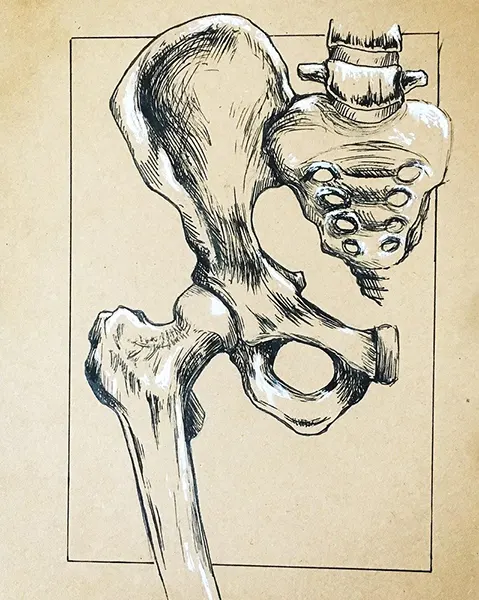Chronic Pelvic Pain Syndrome(CPPS) is a condition characterized by persistent pain in the pelvic region lasting for at least six months, often without a clear identifiable cause.
It is a multifactorial condition involving a complex interplay of physical, psychological, and social factors. It can significantly impact quality of life and may require a multidisciplinary approach for effective management, including medication, physical therapy, and psychological support.
- Persistent pelvic pain or discomfort
- Pain described as dull, aching, or cramping
- Urinary symptoms such as urgency, frequency, or pain during urination
- Pain during sexual intercourse
- Bowel irregularities
- Psychological distress such as anxiety or depression
The causes of Chronic Pelvic Pain Syndrome are often multifactorial and can include:
- Pelvic Floor Dysfunction: Dysfunction or tension in the muscles of the pelvic floor.
- Nerve Dysfunction: Nerves in the pelvic region may become hypersensitive or dysfunctional, contributing to pain sensations.
- Inflammation: Chronic inflammation in the pelvic organs or tissues can lead to ongoing pain.
- Psychological Factors: Emotional stress, anxiety, or past trauma can contribute to the experience and perception of pain.
- Hormonal Imbalances: Fluctuations in hormone levels may play a role in some cases.
- Past Infections or Trauma: Previous pelvic infections or surgeries can lead to ongoing pain.
- Genetic Predisposition: Some individuals may have a genetic predisposition to developing chronic pain conditions.
- Other Medical Conditions: Conditions such as endometriosis, irritable bowel syndrome (IBS), interstitial cystitis, or musculoskeletal disorders can contribute to pelvic pain.
For men, while the exact relationship between CPPS and the prostate is not fully understood, inflammation or dysfunction in the prostate gland or its surrounding structures may contribute to the development or exacerbation of pelvic pain symptoms.
For women, CPPS is often associated with conditions like endometriosis or pelvic inflammatory disease. Additionally, pelvic floor dysfunction and hormonal imbalances may contribute to CPPS in women, highlighting the complex interplay of physiological and psychological factors in this condition.
One of the worst aspects of CPPS is that due to the core nature of the pelvis, you can sometimes be unable to be in any position without pain. Sitting is especially painful, and is something you have to avoid overdoing. But standing, lying down or doing any type of stretch can still be uncomfortable with pelvic pain. It’s almost like there is no escape from it, and so it’s very easy to be in a constant state of distress.
Medication
There are various types of medication that can be prescribed, such as the following ;
- Ibuprofen (Advil, Motrin) or Naproxen (Aleve): Nonsteroidal anti-inflammatory drugs (NSAIDs) that can help reduce inflammation and relieve pain.
- Cyclobenzaprine (Flexeril) or Tizanidine (Zanaflex): Muscle relaxants that can help relax the muscles of the pelvic floor, reducing tension and discomfort.
- Tamsulosin (Flomax): An alpha-blocker that can help relax the muscles in the prostate and bladder neck, potentially improving urinary symptoms in cases where CPPS involves prostate-related issues.
- Amitriptyline (Elavil) or Duloxetine (Cymbalta): Antidepressants that may be prescribed to help manage pain and improve mood in individuals with CPPS.
- Gabapentin (Neurontin) or Pregabalin (Lyrica): Anticonvulsants that may help reduce neuropathic pain symptoms associated with CPPS.
Supplements
There are also different supplements that can help the condition, such as ;
- Omega-3 Fatty Acids: Found in fish oil supplements, omega-3 fatty acids have anti-inflammatory properties and may help reduce inflammation associated with CPPS.
- Magnesium: Magnesium supplementation may help relax muscles and reduce pelvic floor tension, potentially alleviating pain in some individuals.
- Quercetin: This antioxidant found in foods like onions, apples, and berries may have anti-inflammatory effects and could help mitigate pelvic pain symptoms.
- Curcumin (Turmeric): Curcumin, the active compound in turmeric, has anti-inflammatory properties and may provide pain relief for some individuals with CPPS.
- Probiotics: Probiotic supplements containing beneficial bacteria may help support gut health and modulate the immune system, potentially reducing inflammation and improving overall symptoms in some cases of CPPS.
Chronic Pelvic Pain Syndrome (CPPS) presents a complex and challenging clinical landscape, affecting both men and women with a spectrum of symptoms and contributing factors. By recognizing its multifactorial nature and employing a comprehensive treatment approach encompassing medication, physical therapy, psychological support, and supplements, healthcare providers can effectively manage CPPS and improve the lives of those affected by this debilitating condition.









